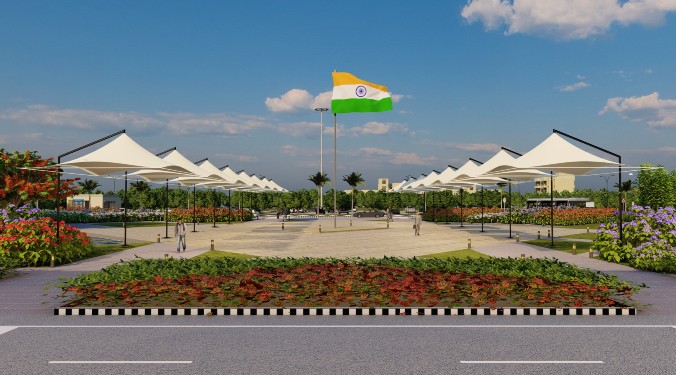“DIAL will continue to provide world-class passenger experience and enhance its operation excellence capabilities through refreshing the entire visual merchandise and consumer connect,” assures I. Prabhakara Rao, CEO, DIAL
Delhi International Airport Pvt. Ltd. (DIAL) is a joint-venture consortium led by GMR with a 54 per cent stake. Its other equity partners include Airports Authority of India (26 per cent), Fraport (10 per cent), and Malaysian Airport Holding Berhard (10 per cent). DIAL’s primary priority includes development and upgrade of Indira Gandhi International Airport (IGIA), the largest infrastructure development project in India after its independence. In an exclusive interview with ACE Update, Mr Prabhakara Rao shares how IGIA has redefined benchmarks of airport development projects.
What measures should be taken to upgrade India’s airport infrastructure to the global level?First, the government should make policy to promote private investment in new airport projects. Private and PPP airport models will be the way forward. In order to attract private capital, a transparent and equitable economic regulatory framework must be defined. The government needs to create an eco-system to provide low-cost, long-term funding for development of infrastructure. For the economic viability of existing PPP airports, the government should ensure fair of return on equity: the sustainability depends upon the fair rate of return on equity and security deposits from the commercialisation of land.
Second, the government also needs to establish Inter-Ministerial Group on Aviation (IMGA) to facilitate faster decision making across the ministries like home, defence, finance, tourism, environment for improved coordination.
Finally, the government should focus on enhancing regional connectivity to have an equitable development of air connectivity across the country.
What are the major challenges the sector is facing today and how is the road ahead?There are, of course, several challenges. The ongoing economic uncertainty has been impacting the overall aviation growth, and most of the airlines are in poor shape, resulting poor cash flows in the system. Even aviation turbine fuel (ATF) price, which accounts for nearly 45 per cent of the operational expenses, are higher in India compared to the international market.
In order to build Greenfield, cargo, and low-cost airports and modernisation of existing airports require huge tracts of land. Many of these large projects are facing opposition from landowners, and the cumbersomeness of the land acquisition process has recently come to significant highlight.
The next challenge is the connectivity to the airports on the outskirts of the city, resulting the commuters to spend more time on travelling to the airports for the shorter routes. This has led to the commuters preferring rail and roads for the shorter routes. The industry is also facing manpower shortage, especially in the technical cadre. Is PPP the only way to boost India’s airport infrastructure?With infrastructure constraints as one of the biggest obstacles to the growth of Indian civil aviation, a good deal has already been invested in airport development. The Indian Civil Aviation Ministry’s Vision 2020 plan stresses a need to develop the country’s infrastructure. It has a particular focus on well-equipped, user-friendly airports to handle as many as 280 million passengers a year. Public-private participation has been successful in building ultra-modern airports in Delhi, Mumbai, Bangalore and Hyderabad. Furthermore, the government’s plans to develop and modernise airports in secondary cities are yet to pick up momentum. PPP models will be instrumental in timely completion and realisation of these projects provided government makes some remarkable improvement in policies pertaining to regulatory framework to ensure economic viability, ecosystem to provide low-cost, long-term funding for development of infrastructure, tax reform for sustainable growth in aviation sector, and support mechanism during the project lifecycle.
How do you wish to utilise commercial opportunities at DIAL?DIAL is set to augment significant value from its non-aeronautical services while enhancing the passenger experience through new facilities such as business centres with meeting rooms with Internet, printing, scanning, photocopy, and fax, among others.DIAL is also to provide integrated market platforms for product promotion (airport radio, airport magazine, displays and promotions at prominent positions inside the airport) as well as gaming arcade for passengers.
DIAL has 230 acres of land for commercial property development of which 45 acres has been developed as a hospitality district. The remaining 185 acres of land will be monetised over the next few years in various phases.
Please update us on the recent development at DIAL.IGIA became the first airport in the country to receive the Airbus 380, the world’s largest passenger aircraft. DIAL organised the third edition of the GMR-IGI Airport Awards which have been instituted to recognise the aviation industry’s key performers who work relentlessly to keep the Delhi Airport operations running 24/7.
DIAL also won the “Golden Peacock Environment Management Award – 2014” for environment management and sustainable development. IGIA achieved the ASQ score of 4.84 for the year 201, becoming the first airport in India to be ranked as 2nd in the 25 – 40 MPPA categories for the third consecutive year.
DIAL will continue to provide world-class passenger experience and enhance its operation excellence capabilities through refreshing the entire visual merchandise and consumer connect, experience-centric development of commercial operations, and catering to the needs of non-passengers.
Its other priorities are making IGIA an international HUB for pax and cargo, supporting Air India joining Star Alliance, and improving the connectivity from New Delhi.
DIAL has also taken a number of initiatives to increase the cargo tonnage at IGIA, including air freight stations, road feeder service and TP cargo, and promoting and increasing pharma, perishable and e-commerce cargo.
In order to improve connectivity to the airport, DIAL has concentrated on metro connectivity at Terminal 1.
DIAL also engages stakeholders through environment sustainability management like implementing carbon neutral initiatives, enhance water resource development, and enhance environmental performance of soil and land at IGIA.
Cookie Consent
We use cookies to personalize your experience. By continuing to visit this website you agree to our Terms & Conditions, Privacy Policy and Cookie Policy.









